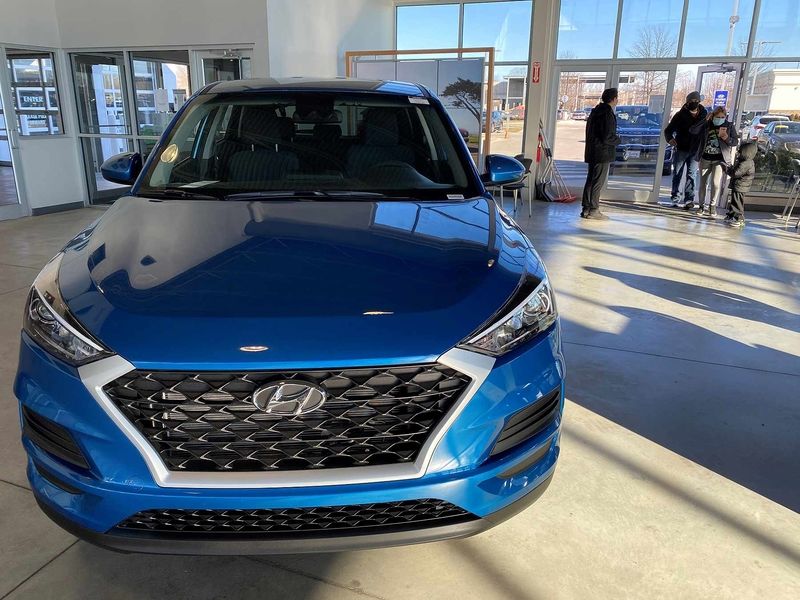
Hyundai’s U.S. sales rose two percent to 43,394 in January behind an 11 percent increase in retail demand for crossovers, signaling light trucks continue to fuel the market’s recovery amid the pandemic.
Overall, retail deliveries edged up 1 percent and fleet volume increased 12 percent last month, Hyundai said Tuesday. Strong retail demand for Hyundai’s expanded crossover was driven by the Santa Fe, up 45 percent; the Venue, up 34 percent, and the Kona, with retail sales up 9 percent.
The latest gains came even as Hyundai dials back on incentives, with TrueCar estimating the brand’s January spiffs at $2,281 a vehicle, down 26 percent from a year earlier. (See chart below.)
“We are off to a strong start to the year and remain optimistic for continued sales and market share gains in 2021,” Randy Parker, senior vice president for national sales at Hyundai Motor America, said in a statement.
Other automakers
Toyota Motor, Honda Motor, Kia, Genesis, Volvo, Mazda and Subaru will report January U.S. sales results later Tuesday. Ford Motor Co. plans to release figures for the month on Wednesday.
U.S. light-vehicle sales are forecast to drop 3.7 percent to 4.9 percent in January, Cox Automotive, J.D. Power and LMC estimate, with strong retail demand offset by ongoing weakness in fleet business.
Industry volume is expected to continue rebounding in 2021, with sales forecast to come in at 15.5 million to 16 million for the year, based on projections from analysts, NADA and some automakers.
While low interest rates, favorable credit conditions and demand for popular new light trucks are driving retail sales, short-term headwinds include a choppy economic recovery from the pandemic, production bottlenecks caused by a microchip shortage and rising transaction prices that are squeezing some buyers out of the new-vehicle market.
“Thin inventories remain a reality for many dealers and consumers, a result of COVID-19 production disruptions, although the worst inventory issues are in the rearview mirror,” Cox Automotive said last week. “Other risks to auto sales include large waves of COVID-19 cases during the winter and a second dip in the economy.”
Cox Automotive senior economist Charlie Chesbrough said an “expected month-over-month uptick in the sales pace suggests the vehicle market is starting the year on solid ground even with so much uncertainty in the economy.”
Overall, car and light-truck volume fell 14 percent last year to 14.6 million, the lowest tally since 14.49 million in 2012, when the economy was still rebounding from the 2008-09 financial crisis.
SAAR outlook
The seasonally adjusted, annualized rate of sales for January is expected to tally 15.9 million to 16.4 million, based on projections from Cox Automotive, TrueCar and J.D. Power and Associates. That would be down from the 17.05 million rate in January 2020 and roughly on par with December’s 16.38 million pace, and still the sixth straight month the sales pace has topped 15 million.
Incentives
The average incentive on a new vehicle was tracking at $3,639 last month, a decrease of $510 from Jan. 2020, J.D. Power said. TrueCar estimates January spiffs averaged $3,839, down 7.5 percent from a year earlier.
Odds, ends
- There were 24 selling days last month vs. 25 in January 2020.
- The average number of days a new vehicle sat on a dealer lot before being sold in January was on pace to fall to 51 days, down 19 days from last year, Power said.
- Fleet deliveries are expected to total 182,300 last month, off sharply from January 2020, and account for 17 percent of all light-vehicle volume, down from 22 percent a year ago.
“Entering 2021 with retail sales in line with last year is a big win for the automotive industry. A handful of brands such as Ford, Genesis, GMC, Ram and Toyota, appear to be in the coveted quadrant of both retail growth as well as incentive decline. This is mostly driven by new product and being in the right segments or a combination of the two.”
— Nick Woolard, TrueCar analyst